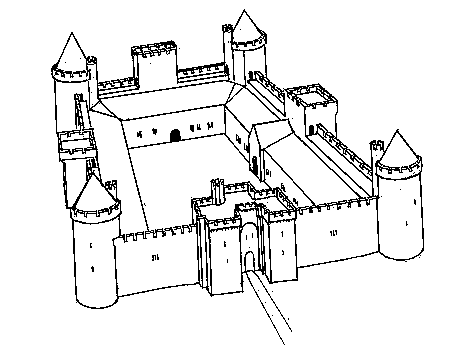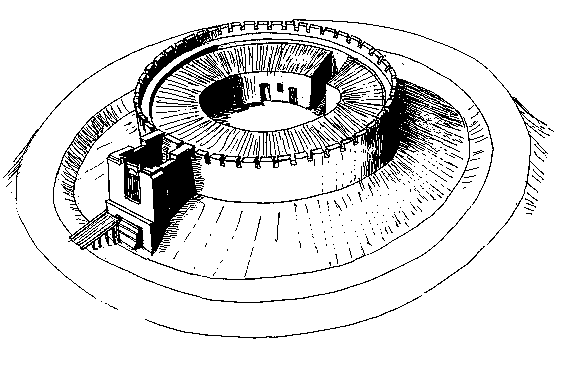What is a Castle?By Stephen Francis WyleyDrawings by Steven Lowe |
|---|

What is a Castle? Is it a masonry edifice constructed on a hilltop with tall towers punctuating the curtain walls topped by battlements? Can you imagine a column of knights in full plate armour mounted on war horses charging out of the main gate over the lowered drawbridge to do battle against an attacking enemy force, while beautifully coiffed ladies watch from a tower window, and serfs till the earth to grow harvest so that the lord of the castle can continue to spend money on courtly pursuits and new armour form Italy or Germany? This imagined spectacle represents the feudal system where the castle was a place of both residence and defence for a lord.
On the other hand was a castle simply a base for military and administrative operations, such as; dispensing justice and collecting taxes and tolls; subjugating conquered lands; suppressing rebellion and unrest; acting as a base for raids or invasions; protecting trade and territory from attack or just to attack another castle.
Whatever the case, the castle has become a visual symbol of the Medieval period and everyone has their own view of the subject, be it coloured by their educational background and the bounds of their imagination.
As I have in fact studied the subject of military architecture to some extent I found that my definition of a castle is different to those less unacquainted on the subject. What are your ideas on the definition of a castle?
Some of the constructions that are given the name ‘castle’ are in fact not castles at all. Oman I think puts it very well:
“The word castle is linked to all manner of things, from prehistoric earthworks down to preposterous erections of the twentieth century, with mock battlements and sham drawbridges, built for misguided lovers of the romantic or for ostentatious profiteers.”
Since the Roman Juvenal call the British hillforts castella around 120 A.D., such sites have been called castles, for example the multivallate hillfort near Dorsetshire in England is known to many as Maiden Castle.
And then there is the sad examples of Victorian and Modern architecture which grate on the eye nerve and make me cringe with disgust, especially when the owners make a profit from beguiling the unwary public and even receive grants from the government to do it ( Bunratty and Kryall are two places that spring to mind).
The French use the word chateau for castle but it used to cover both: the Chateau-Gaillard, a fortress of the 12th century; and the manors dating from the 12th to the 18th century, which have no or little defensive capability.

The Roman Mile Castle (see figure 2), which punctuate Hadrian’s Wall are not in fact castles but towers defending the wall which forms a much larger fortification defending a frontier. If a Mile Castle is a castle then take the argument further then every tower along the walls of Carcassone in France is therefore a castle unto itself, which is an absurd proposition since the towers from part of a district circuit around a town and are too small to be considered a castle by themselves.
A fortified town, surrounded by curtain walls punctuated by flanking towers and other defences can not be call a castle because of its large size. It would come under the category of ‘fortress’. Even though a castle maybe attached or site within the walls, a good example in Caernarvon in Wales, the castle is still a distinct unit unto itself, being able to cut off from the town by closing a gate or raising a drawbridge.
There have been numerous authors who have written books covering the topic of castles and other fortifications, and some of the more noted authors should have their definitions noted.
Sidney Toy, A History of Fortification from 3000 B.C. to 1700 A.D. wrote;
“The Castle is considered in its military aspect, as a fortress, and its domestic arrangements only in so far as they are ancillary to its function as a fortification and are necessary in its residence.”
William Anderson, the author of "Castles of Western Europe" wrote;
“...The castle has a double nature; it is both a home and a fortress...(It is) this double nature which makes the castle so different from dwellings and fortification of other periods.”
According to Sir Charles Oman in his book ‘Castles’ stated that the following;
"A castle is a military structure larger than a tower but smaller than a fortified town, it is residential but is also defensible in character. However complicated internally it must be a complete unit unto itself and not part of a town. A castle may exist inside a town but must be able to be cut off by the closing of a gate or the raising of a drawbridge."
And finally the definition of a castle which appears in my own manuscript entitled "A Dictionary of Military Architecture",
“A fortified building or set of buildings used to provide both active and passive defence. as well as a residence for the castle's lord and household.”
And in fact after researching and writing this piece I will have to change my entry for the definition of a castle.
All these definitions have some merit, but the point about the castle being the property of a single owner or feudal lord needs addressing. Castles were also owned or held by orders of knights. religious orders, republican states and commonwealths. And even the king of England did not own the Tower of London as a private person but as king. Therefore the question of ownership effecting the definition of a castle is removed, and the only conditions applying to the term castle are purpose size and character.

Over the Medieval period a number of different types of castle designs were used, such as the motte and bailey castles (see figure 3), the keep and bailey, using a range of keep designs (eg shell (see figure 4), rectangular, square, quatrefoil, round and polygonal keeps), quadrangular castles (see figure 1), keep-less castles, and the concentric castles. There were certainly other types and variations on themes coming under the definition provided in this text.

The history of the word castle is worth noting because of the confusion created by both Medieval chroniclers and Modern historians in their mistranslations of such words as castrum, castellum and other similar words. Castrum vaguely means any enclosed place such as a fort or stronghold of any type. The plural of Castrum is Castra, which was used to denote a legionary fort, and castellum is the diminutive of castrum. So when Wycliffe translated the Latin bible into English he thought castella was a little town. When the Vulgate translation was made in the early fifth century castellum and castrum were still being used in a vague sense, both being applied to centres of population either big or small, fortified or not. When St Jerome translated the New Testament into Latin he used Castellum to mean a village of any type so when the author of Cursos Mundi about 1300 AD, stated that Bethany was the castle of Lazarus, Martha and Mary, in which they entertained Jesus, he was thinking of a fortified residence.
In Carolingian France and Anglo-Saxon England in the eighth and ninth century's castellum was used to mean a habitation of any size, for example Egbert of Kent and Offa of Mercia both called Rochester a castellum, and the sizeable towns of Macon and Vitry were called castella by a Frankish chronicler. It was not until the tenth century that the word actually began to be used in its actual sense of a fortified residential building. Since no new word was coined to cover this new phenomenon this confusion arose, and thus both Medieval and Modern historians have misunderstood and passed on that misunderstanding to others.
In the transition period between the senses in the tenth and eleventh centuries it is impossible to discover whether a writer was writing about a town or a fortified stronghold, except from the context in which it was written. The phenomenon of the castle spread throughout Europe and beyond, and many variations of the word were derived, such as Chateau, Kastel, Castello, Castillo. Kastros, Kastris and Castelle.
Allen Brown, R., English Medieval Castles, London, 1954.
Allen Brown, R., Castles - A History and Guide, Dorset, 1985.
Anderson, W., Castles of Europe, Hertfordshire, 1984.
Barrucand, M. & Bednorz, A., Moorish Architecture in Andalusia,
Köln, 1992.
Brice, M.H., Forts and Fortresses, London, 1990.
Brice, M.H., Stronghold: A History of Military Architecture, London,
1984.
Bottomley, F., The Castle Explorer’s Guide, London, 1979.
De Breffney, B., Castles of Ireland, London, 1977.
Duby, G., France in the Middle Ages 987 - 1460, USA, 1991.
Edwards, R.W., The Fortifications of Amenian Cilica, Washington D.C.,
1987.
Fass, V., The Forts of India, London, 1986.
Forde-Johnston, P., Hadrian's Wall, London, 1977.
Fry, P.S., British Medieval Castles, London, 1974.
Gebelin, F., The Chateaux of France, London, 1964.
Gravett, C., Medieval Siege Warfare, London, 1990.
Guilbert, G., Ed., Hill-Forts Studies, Leicester, 1981.
Hinago, M., Japanese Castles, Japan, 1986.
Hogg, I., The History of Fortification, London, 1981.
Hughes, Q., Military Architecture, London, 1974.
Johnson, A., Roman Forts, London, 1983.
Johnston, P., The National Trust Book of British Castles, London, 1979.
Johnston, P., Castles of England, Scotland and Wales, London, 1989.
Kennedy, H., Crusader Castles, Cambridge, 1995.
Knightly, C., Strongholds of the Realm, London, 1979.
Lawrence, T.E., Crusader Castles, London, 1986.
Manley J., Atlas of Prehistoric Britain, London, 1989.
Minney, R.J., The Tower of London, 1971.
Muller, J., Treatise of Fortifications, 1746. Reprinted Ontario, 1968.
Oman, C., Sir, Castles, New York, 1978.
Pognon, E. Les Très Riches Heures de duc de Berry, Geneva, 1983.
Ross, S., Scottish Castles, Moffat, 1990.
Sorrel, A., British Castles, London, 1973.
Smith, Capt. G., An Universal Military Dictionary, 1779. Reprinted
Ontario, 1969.
Tabarelli, G.M., Ideal and Fortified Cities of the Renaissance, Arts,
Arms and Armour, An International Anthology Volume 1, 1979 - 80, Switzerland,
1979.
Toy, S., A History of Fortifications from 3000 BC to AD 1700, London,
1955.
Tsangadas, B.C.P., The Fortifications and Defense of Constantinople,
New York, 1980.
Tuulse, A., Castles of the Western World, Austria, 1958.
Warner, P., Sieges of the Middle Ages, London, 1968.
Weissmüller, A.A., Castles From the Heart of Spain, London, 1967.
A
Dictionary of Military Architecture
An
Aerial View of Masada
Anglo-Saxon
Burhs
Bibliography
of Military Architecture
David's
Tower, Jerusalem
Drawings
of Aspects of Military Architecture
Jerusalem
from the Mount of Olives
More
Pictures of the Theodosian Land Walls
Siege
Warfare, The Art of Offence and Defence
Shiro,
A Japanese Castle
The
Walls of Ankara
The
Defences of Constantinople
The
Town Walls of Conwy
What
is a Castle?
| Copyright © Stephen Francis Wyley 1998 - 2002
svenskildbiter@angelfire.com |